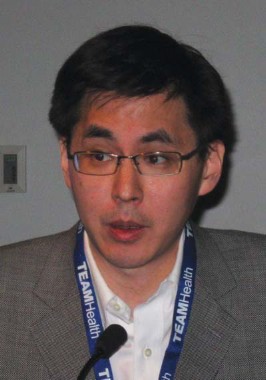User login
DENVER – An emergency department protocol for observing patients who present with unexplained syncope substantially reduced health care services and costs with no evidence of harm, compared with routine hospital admission for observation.
The findings were seen in a multicenter randomized trial conducted in five diverse hospital settings, indicating the syncope observation protocol is applicable in EDs regardless of whether they’re located in academic medical centers, small community hospitals, or big county public hospitals, Dr. Benjamin Sun noted at the annual meeting of the American College of Emergency Physicians.
The observation protocol is designed for syncope patients over age 50 identified in the ED as being at intermediate risk for subsequent serious events such as stroke, MI, or life-threatening arrhythmia.
Patients clearly at high risk, such as those who presented with syncope related to a dangerous arrhythmia or an MI, were routinely admitted straightaway for inpatient care. Those whose syncope was identified in the ED as low-risk – that is, likely due to a benign cause such as vasovagal or orthostatic syncope – were quickly discharged, explained Dr. Sun of Oregon Health and Sciences University, Portland.
The core elements of the observation protocol consisted of serial troponin testing, 12-24 hours of ECG monitoring, and selective use of echocardiography. Head CT and other ancillary testing was done at physician’s discretion and varied widely among the study sites according to local practice. The ED syncope observation units were run by emergency physicians and staffed by mid-level providers.
Dr. Sun reported on 124 intermediate-risk patients at five participating EDs who were randomized to the ED observation protocol or to routine inpatient unstructured care, which is how such patients are typically managed in the United States.
The ED-run protocol resulted in dramatic savings: Only 11% of patients assigned to that strategy were ultimately admitted to the hospital. Roughly 80% of those admissions occurred because an arrhythmia was identified during ED observation, while the other 20% were due to troponin leaks. The mean length of stay for syncope patients assigned to ED observation was 29 hours, compared with 46 hours for controls. Thirty-day hospital costs averaged $2,100 in the ED observation group compared with $3,500 for controls.
Rates of serious adverse events such as stroke, MI, or pulmonary embolism within 30 days and 6 months post discharge were in similarly low single figures in both study arms. Quality of life scores in the two groups were also similar, bolstering the conclusion that the ED syncope observation protocol saved money without causing harm, Dr. Sun continued.
The ED protocol was developed in an effort to come up with a better way to manage the more than 700,000 patients per year who present with syncope to EDs. Such patients are frequently hospitalized, even if they’re at low or intermediate risk. Hospitalizations for syncope account for more than $2.4 billion annually in health care costs with little evidence of benefit. Medicare has identified this line item as a high-priority target for cost reduction, he noted.
Dr. Sun reported having no financial conflicts.
DENVER – An emergency department protocol for observing patients who present with unexplained syncope substantially reduced health care services and costs with no evidence of harm, compared with routine hospital admission for observation.
The findings were seen in a multicenter randomized trial conducted in five diverse hospital settings, indicating the syncope observation protocol is applicable in EDs regardless of whether they’re located in academic medical centers, small community hospitals, or big county public hospitals, Dr. Benjamin Sun noted at the annual meeting of the American College of Emergency Physicians.
The observation protocol is designed for syncope patients over age 50 identified in the ED as being at intermediate risk for subsequent serious events such as stroke, MI, or life-threatening arrhythmia.
Patients clearly at high risk, such as those who presented with syncope related to a dangerous arrhythmia or an MI, were routinely admitted straightaway for inpatient care. Those whose syncope was identified in the ED as low-risk – that is, likely due to a benign cause such as vasovagal or orthostatic syncope – were quickly discharged, explained Dr. Sun of Oregon Health and Sciences University, Portland.
The core elements of the observation protocol consisted of serial troponin testing, 12-24 hours of ECG monitoring, and selective use of echocardiography. Head CT and other ancillary testing was done at physician’s discretion and varied widely among the study sites according to local practice. The ED syncope observation units were run by emergency physicians and staffed by mid-level providers.
Dr. Sun reported on 124 intermediate-risk patients at five participating EDs who were randomized to the ED observation protocol or to routine inpatient unstructured care, which is how such patients are typically managed in the United States.
The ED-run protocol resulted in dramatic savings: Only 11% of patients assigned to that strategy were ultimately admitted to the hospital. Roughly 80% of those admissions occurred because an arrhythmia was identified during ED observation, while the other 20% were due to troponin leaks. The mean length of stay for syncope patients assigned to ED observation was 29 hours, compared with 46 hours for controls. Thirty-day hospital costs averaged $2,100 in the ED observation group compared with $3,500 for controls.
Rates of serious adverse events such as stroke, MI, or pulmonary embolism within 30 days and 6 months post discharge were in similarly low single figures in both study arms. Quality of life scores in the two groups were also similar, bolstering the conclusion that the ED syncope observation protocol saved money without causing harm, Dr. Sun continued.
The ED protocol was developed in an effort to come up with a better way to manage the more than 700,000 patients per year who present with syncope to EDs. Such patients are frequently hospitalized, even if they’re at low or intermediate risk. Hospitalizations for syncope account for more than $2.4 billion annually in health care costs with little evidence of benefit. Medicare has identified this line item as a high-priority target for cost reduction, he noted.
Dr. Sun reported having no financial conflicts.
DENVER – An emergency department protocol for observing patients who present with unexplained syncope substantially reduced health care services and costs with no evidence of harm, compared with routine hospital admission for observation.
The findings were seen in a multicenter randomized trial conducted in five diverse hospital settings, indicating the syncope observation protocol is applicable in EDs regardless of whether they’re located in academic medical centers, small community hospitals, or big county public hospitals, Dr. Benjamin Sun noted at the annual meeting of the American College of Emergency Physicians.
The observation protocol is designed for syncope patients over age 50 identified in the ED as being at intermediate risk for subsequent serious events such as stroke, MI, or life-threatening arrhythmia.
Patients clearly at high risk, such as those who presented with syncope related to a dangerous arrhythmia or an MI, were routinely admitted straightaway for inpatient care. Those whose syncope was identified in the ED as low-risk – that is, likely due to a benign cause such as vasovagal or orthostatic syncope – were quickly discharged, explained Dr. Sun of Oregon Health and Sciences University, Portland.
The core elements of the observation protocol consisted of serial troponin testing, 12-24 hours of ECG monitoring, and selective use of echocardiography. Head CT and other ancillary testing was done at physician’s discretion and varied widely among the study sites according to local practice. The ED syncope observation units were run by emergency physicians and staffed by mid-level providers.
Dr. Sun reported on 124 intermediate-risk patients at five participating EDs who were randomized to the ED observation protocol or to routine inpatient unstructured care, which is how such patients are typically managed in the United States.
The ED-run protocol resulted in dramatic savings: Only 11% of patients assigned to that strategy were ultimately admitted to the hospital. Roughly 80% of those admissions occurred because an arrhythmia was identified during ED observation, while the other 20% were due to troponin leaks. The mean length of stay for syncope patients assigned to ED observation was 29 hours, compared with 46 hours for controls. Thirty-day hospital costs averaged $2,100 in the ED observation group compared with $3,500 for controls.
Rates of serious adverse events such as stroke, MI, or pulmonary embolism within 30 days and 6 months post discharge were in similarly low single figures in both study arms. Quality of life scores in the two groups were also similar, bolstering the conclusion that the ED syncope observation protocol saved money without causing harm, Dr. Sun continued.
The ED protocol was developed in an effort to come up with a better way to manage the more than 700,000 patients per year who present with syncope to EDs. Such patients are frequently hospitalized, even if they’re at low or intermediate risk. Hospitalizations for syncope account for more than $2.4 billion annually in health care costs with little evidence of benefit. Medicare has identified this line item as a high-priority target for cost reduction, he noted.
Dr. Sun reported having no financial conflicts.
AT THE ANNUAL MEETING OF THE AMERICAN COLLEGE OF EMERGENCY PHYSICIANS
Major Finding: An ED-based observation protocol for patients presenting with unexplained syncope drastically decreased hospital admissions, reduced mean length of stay by one-third, and cut 30-day hospital costs by 40% compared with conventional inpatient observation.
Data Source: A randomized trial of 124 patients who were judged to be at intermediate risk of future adverse events such as MI or arrhythmia.
Disclosures: Dr. Sun reported having no financial conflicts.

